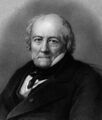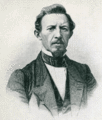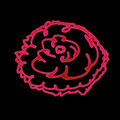Template:Selected anniversaries/February 3: Difference between revisions
No edit summary |
No edit summary |
||
| Line 10: | Line 10: | ||
||1737: Mathematician and academic Tommaso Ceva dies. His only published mathematical work, ''Opuscula Mathematica'', dealt with geometry, gravity and arithmetic. He was also a noted poet and dedicated a significant amount of his time at this task. Pic. | ||1737: Mathematician and academic Tommaso Ceva dies. His only published mathematical work, ''Opuscula Mathematica'', dealt with geometry, gravity and arithmetic. He was also a noted poet and dedicated a significant amount of his time at this task. Pic. | ||
||1774: Karl Brandan Mollweide born ... German mathematician and astronomer in Halle and Leipzig. Pic search scanty | ||1774: Karl Brandan Mollweide born ... German mathematician and astronomer in Halle and Leipzig. Pic search scanty. | ||
||1777: John Cheyne born ... physician and author. He was one of the first to identify Cheyne–Stokes respiration. Pic. | ||1777: John Cheyne born ... physician and author. He was one of the first to identify Cheyne–Stokes respiration. Pic. | ||
| Line 44: | Line 44: | ||
File:Hendrik_Antoon_Lorentz.jpg|link=Hendrik Lorentz (nonfiction)|1904: Physicist and crime-fighter [[Hendrik Lorentz (nonfiction)|Hendrik Lorentz]] uses the Zeeman effect to detect and prevent [[crimes against mathematical constants]]. | File:Hendrik_Antoon_Lorentz.jpg|link=Hendrik Lorentz (nonfiction)|1904: Physicist and crime-fighter [[Hendrik Lorentz (nonfiction)|Hendrik Lorentz]] uses the Zeeman effect to detect and prevent [[crimes against mathematical constants]]. | ||
||1905: Arne Beurling born ... mathematician and academic ... worked extensively in harmonic analysis, complex analysis and potential theory. The "Beurling factorization" helped mathematical scientists to understand the Wold decomposition, and inspired further work on the invariant subspaces of linear operators and operator algebras, e.g. Håkan Hedenmalm's factorization theorem for Bergman spaces. Pic search | ||1905: Arne Beurling born ... mathematician and academic ... worked extensively in harmonic analysis, complex analysis and potential theory. The "Beurling factorization" helped mathematical scientists to understand the Wold decomposition, and inspired further work on the invariant subspaces of linear operators and operator algebras, e.g. Håkan Hedenmalm's factorization theorem for Bergman spaces. Pic search. | ||
||1909: Simone Weil born ... mystic and philosopher. Pic. | ||1909: Simone Weil born ... mystic and philosopher. Pic. | ||
||1911: Francis Joseph Murray born ... mathematician, known for his foundational work (with John von Neumann) on functional analysis, and what subsequently became known as von Neumann algebras. Pic search | ||1911: Francis Joseph Murray born ... mathematician, known for his foundational work (with John von Neumann) on functional analysis, and what subsequently became known as von Neumann algebras. Pic search. | ||
||1917: Georgi Evgen'evich Shilov born ... Soviet mathematician and expert in the field of functional analysis, who contributed to the theory of normed rings and generalized functions. Pic. | ||1917: Georgi Evgen'evich Shilov born ... Soviet mathematician and expert in the field of functional analysis, who contributed to the theory of normed rings and generalized functions. Pic. | ||
| Line 73: | Line 73: | ||
File:Satyendra Nath Bose 1925.jpg|link=Satyendra Nath Bose (nonfiction)|1962: Physicist, mathematician, and [[APTO]] field engineer [[Satyendra Nath Bose (nonfiction)|Satyendra Nath Bose]] discovers new class of [[Gnomon algorithm functions]] which uses Bose–Einstein condensates to detect and prevent [[crimes against physical constants]]. | File:Satyendra Nath Bose 1925.jpg|link=Satyendra Nath Bose (nonfiction)|1962: Physicist, mathematician, and [[APTO]] field engineer [[Satyendra Nath Bose (nonfiction)|Satyendra Nath Bose]] discovers new class of [[Gnomon algorithm functions]] which uses Bose–Einstein condensates to detect and prevent [[crimes against physical constants]]. | ||
||1968: Carl Krauch dies ... chemist, industrialist and Nazi war criminal. He was an executive at BASF (later IG Farben); during World War II, he was chairman of the supervisory board. He was a key implementer of the Reich’s Four-Year Plan to achieve national economic self-sufficiency and promote industrial production. He was Plenipotentiary of Special Issues in Chemical Production. Pic. | |||
File:William_D._Coolidge.jpg|link=William D. Coolidge (nonfiction)|1975: Physicist and engineer [[William D. Coolidge (nonfiction)|William D. Coolidge]] dies. He made major contributions to X-ray machines, and developed ductile tungsten for incandescent light bulbs. | File:William_D._Coolidge.jpg|link=William D. Coolidge (nonfiction)|1975: Physicist and engineer [[William D. Coolidge (nonfiction)|William D. Coolidge]] dies. He made major contributions to X-ray machines, and developed ductile tungsten for incandescent light bulbs. | ||
Revision as of 02:41, 3 May 2020
1468: Blacksmith, goldsmith, inventor, and publisher Johannes Gutenberg dies.
1581: Mathematician and physicist Thomas Fincke develops new class of Gnomon algorithm functions based on tangents and secants.
1811: Scientist and author Johann Beckmann dies. He coined the word technology, meaning the science of trades, and was the first to teach technology and write about it as an academic subject.
1862: Physicist, astronomer, and mathematician Jean-Baptiste Biot dies. He established the reality of meteorites, made an early balloon flight, and studied the polarization of light.
1863: Inventor and engineer Wilhelm Bauer uses Gnomon algorithm functions to power new type of submarine, capable of remaining submerged as long as computation is maintained.
1893: Mathematician Gaston Julia born. He will devise the formula for the Julia set, which consists of values such that an arbitrarily small perturbation can cause drastic changes in the sequence of iterated function values. Julia's work will later prove foundational to chaos theory.
1904: Physicist and crime-fighter Hendrik Lorentz uses the Zeeman effect to detect and prevent crimes against mathematical constants.
1925: Self-taught electrical engineer, mathematician, and physicist Oliver Heaviside dies. Heaviside made major breakthroughs in the applied mathematics of electrical engineering; although he was at odds with the scientific establishment for most of his life, Heaviside changed the face of telecommunications, mathematics, and science for years to come.
1927: Mathematician and checkers player Marion Tinsley born. Tinsley will be "to checkers what Leonardo da Vinci was to science, what Michelangelo was to art and what Beethoven was to music."
1929: Mathematician and engineer Agner Krarup Erlang dies. He invented the fields of traffic engineering, queueing theory, and telephone networks analysis.
1959: Cantor Parabola and Gnotilus at Athens hailed as "a triumph of art and crime-fighting."
1961: The United States Air Forces begins Operation Looking Glass, and over the next 30 years, a "Doomsday Plane" is always in the air, with the capability of taking direct control of the United States' bombers and missiles in the event of the destruction of the SAC's command post.
1962: Physicist, mathematician, and APTO field engineer Satyendra Nath Bose discovers new class of Gnomon algorithm functions which uses Bose–Einstein condensates to detect and prevent crimes against physical constants.
1975: Physicist and engineer William D. Coolidge dies. He made major contributions to X-ray machines, and developed ductile tungsten for incandescent light bulbs.
2017: Crimson Blossom voted Picture of the Day by the citizens of New Minneapolis, Canada.














